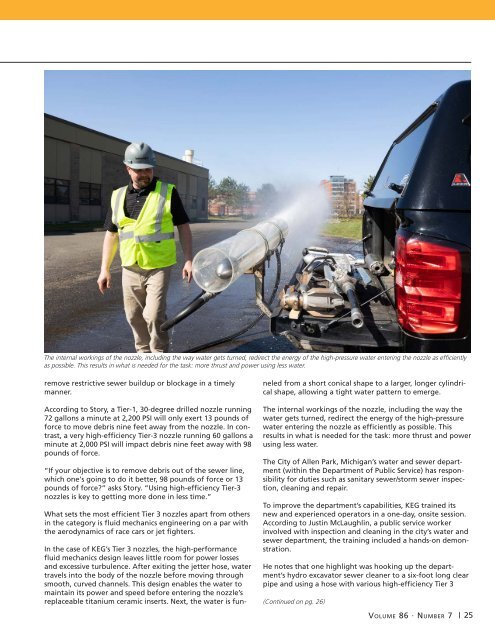CEAC-2021-07-July
You also want an ePaper? Increase the reach of your titles
YUMPU automatically turns print PDFs into web optimized ePapers that Google loves.
The internal workings of the nozzle, including the way water gets turned, redirect the energy of the high-pressure water entering the nozzle as efficiently<br />
as possible. This results in what is needed for the task: more thrust and power using less water.<br />
remove restrictive sewer buildup or blockage in a timely<br />
manner.<br />
According to Story, a Tier-1, 30-degree drilled nozzle running<br />
72 gallons a minute at 2,200 PSI will only exert 13 pounds of<br />
force to move debris nine feet away from the nozzle. In contrast,<br />
a very high-efficiency Tier-3 nozzle running 60 gallons a<br />
minute at 2,000 PSI will impact debris nine feet away with 98<br />
pounds of force.<br />
“If your objective is to remove debris out of the sewer line,<br />
which one's going to do it better, 98 pounds of force or 13<br />
pounds of force?” asks Story. “Using high-efficiency Tier-3<br />
nozzles is key to getting more done in less time.”<br />
What sets the most efficient Tier 3 nozzles apart from others<br />
in the category is fluid mechanics engineering on a par with<br />
the aerodynamics of race cars or jet fighters.<br />
In the case of KEG’s Tier 3 nozzles, the high-performance<br />
fluid mechanics design leaves little room for power losses<br />
and excessive turbulence. After exiting the jetter hose, water<br />
travels into the body of the nozzle before moving through<br />
smooth, curved channels. This design enables the water to<br />
maintain its power and speed before entering the nozzle’s<br />
replaceable titanium ceramic inserts. Next, the water is funneled<br />
from a short conical shape to a larger, longer cylindrical<br />
shape, allowing a tight water pattern to emerge.<br />
The internal workings of the nozzle, including the way the<br />
water gets turned, redirect the energy of the high-pressure<br />
water entering the nozzle as efficiently as possible. This<br />
results in what is needed for the task: more thrust and power<br />
using less water.<br />
The City of Allen Park, Michigan’s water and sewer department<br />
(within the Department of Public Service) has responsibility<br />
for duties such as sanitary sewer/storm sewer inspection,<br />
cleaning and repair.<br />
To improve the department’s capabilities, KEG trained its<br />
new and experienced operators in a one-day, onsite session.<br />
According to Justin McLaughlin, a public service worker<br />
involved with inspection and cleaning in the city’s water and<br />
sewer department, the training included a hands-on demonstration.<br />
He notes that one highlight was hooking up the department’s<br />
hydro excavator sewer cleaner to a six-foot long clear<br />
pipe and using a hose with various high-efficiency Tier 3<br />
(Continued on pg. 26)<br />
Volume 86 · Number 7 | 25


















